There are a number of different types of jasmine Bonsai trees, all suited for intricate shaping and pruning. Depending on the plant you are talking about, there are different jasmine Bonsai tree species and cultivars. However, all options produce delicate flowers, often fragrant and blooming profusely during the springtime when well-cared for.
Whether you plan on caring for a water jasmine Bonsai tree or a common jasmine plant cultivar, there are a number of things to consider before getting started. With a somewhat complicated growth habit and temperature needs, keeping a jasmine Bonsai tree is a bit more advanced than average. However, with this care guide, it may be easier than you think. Let’s take a closer look at jasmine Bonsai trees now.
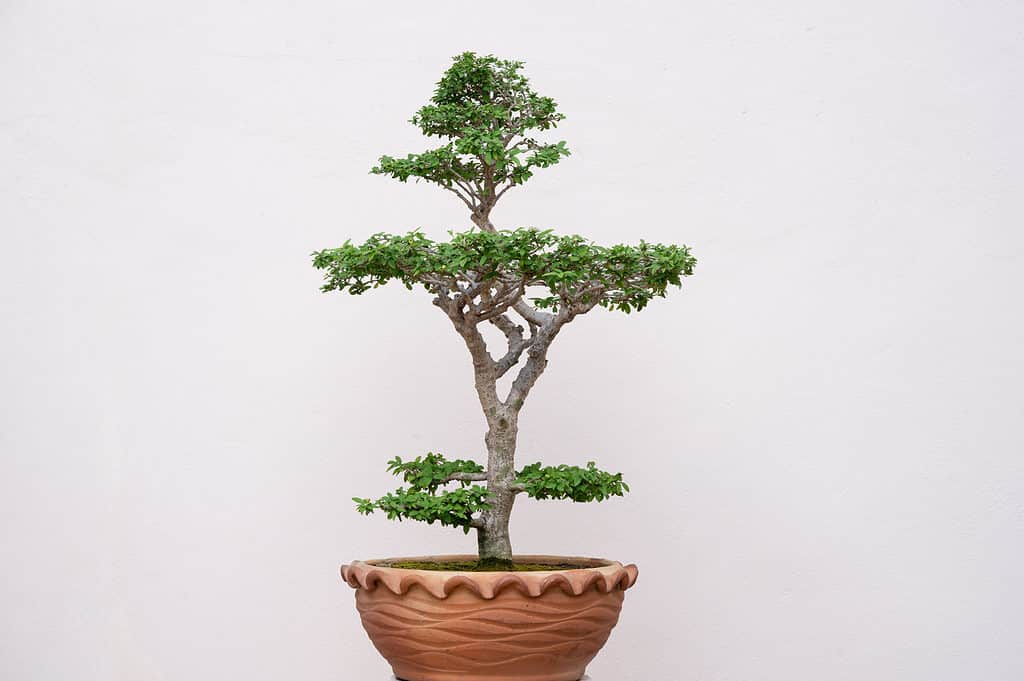
Not to be confused with standard jasmine plants, water jasmine Bonsai trees are revered and popular.
©mokjc/Shutterstock.com
| Jasmine Bonsai Tree Facts | |
|---|---|
| Botanical Name | Trachelospermum jasminoides; Chrysojasminum parkeri; Wrightia religiosa |
| Popular Options | Star jasmine, Arabian jasmine, common jasmine, dwarf jasmine |
| Sunlight | Full, direct sunshine, both indoors and out |
| Soil | Well-draining and a mixture of clay, organic materials, and peat |
| Water | Keep moist, with higher humidity levels, particularly when kept indoors |
| For Beginners? | Intermediate; may be tricky to care for indoors |
| Indoors or Outdoors? | Both, depending on climate; primarily indoors |
| Pairs Well With… | Moss, stones, and a style that supports flower production and consistent pruning! |
Common Types of Jasmine Bonsai Trees
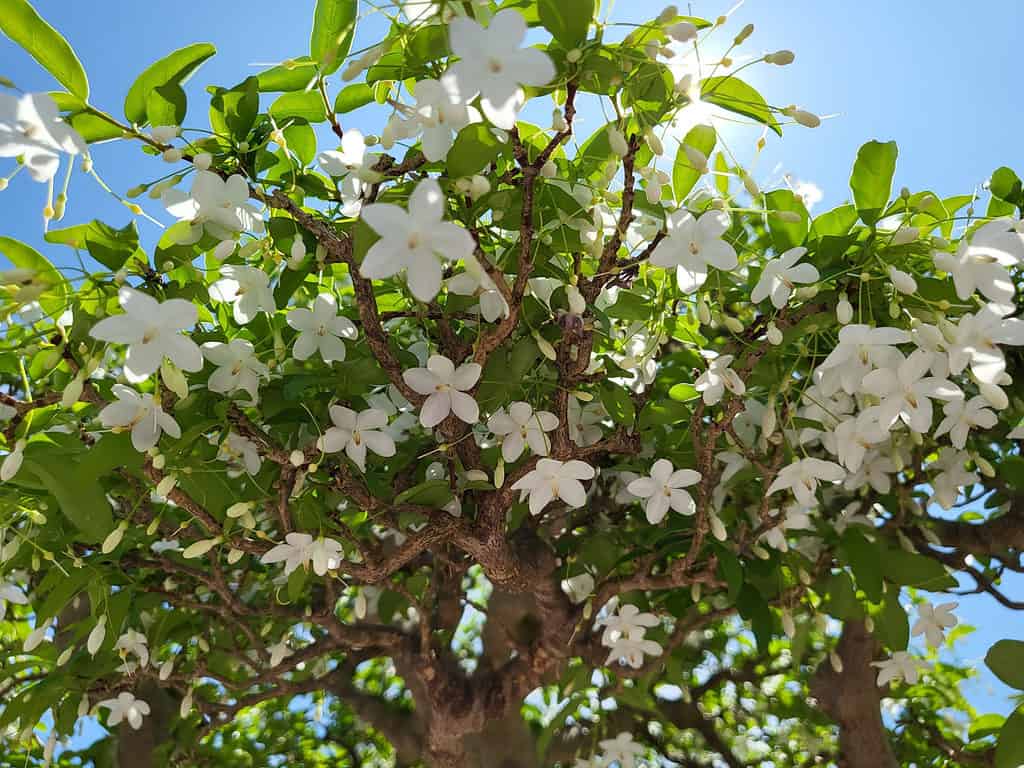
It can be incredibly confusing to look at a water jasmine Bonsai tree and compare it with a standard white jasmine specimen or a common jasmine specimen.
©NOOR RADYA BINTI MD RADZI/Shutterstock.com
It’s important to note that there are many different types of jasmine plants, across many different genera and species. For example, some jasmine specimens belong to the Jasminium genus, while others belong to the Trachelospermum genus. Some gardenias are named jasmine, and water jasmine plants produce white flowers too but belong to a completely different genus!
To clear up some confusion, let’s take a closer look and compare two of the most common types of jasmine Bonsai trees now.
Water Jasmine vs White Jasmine
It can be incredibly confusing to look at a water jasmine Bonsai tree and compare it with a standard white jasmine specimen or a common jasmine specimen. However, water jasmine Bonsai trees belong to an entirely different plant family compared to most jasmine plants. They both have somewhat tropical plant needs and must always be cultivated indoors, but it’s important to know what type of jasmine Bonsai tree you plan on growing.
For example, the Jasminum genus contains roughly 200 different jasmine plant species found around the world, while water jasmine plants belong to the Wrightia genus and are native to China. Water jasmine Bonsai trees are revered and used as Bonsai trees in Buddhist temples, still offering a gentle fragrance akin to standard jasmine flowers.
Know that water jasmine plants and other types of jasmine plants make beautiful specimens equally! However, being able to tell the difference between them is key for their overall wellness and care.
Star Jasmine
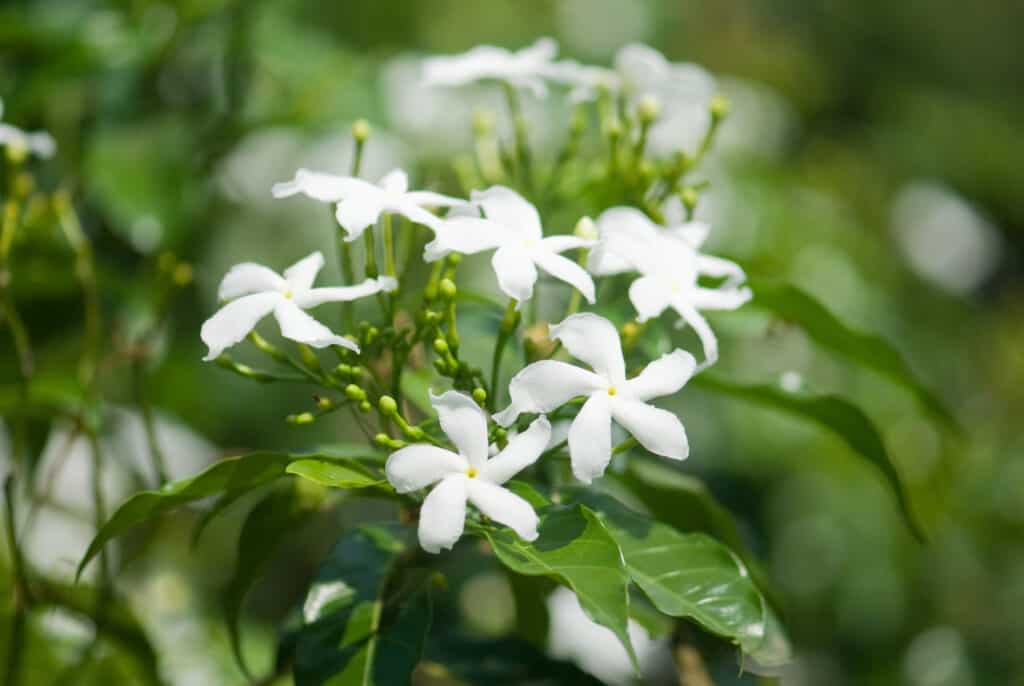
Given that there are so many different types of plants known as jasmine, caring for a jasmine Bonsai tree should be done based on the specific plant species that you happen to own.
©Tukaram.Karve/Shutterstock.com
Likely one of the most common flowering jasmine Bonsai tree cultivars, star jasmine goes by many names. With a vining growth habit and delicate white flowers, star jasmine is fragrant and occasionally difficult to prune. However, this specimen is popularly grown in containers, making the transition to a Bonsai tree size fairly easy! It is hardy only in Zones 8-10.
Dwarf Jasmine
Botanically classified as Chrysojasminum parkeri, this particular jasmine plant produces small yellow flowers as opposed to white. However, many different jasmine plant species are referred to as dwarf jasmine plants, so make sure you know which option you have before caring for it. This plant will need plenty of winter protection, especially when grown as a Bonsai tree. It reaches an average of only a foot tall, making it a particularly small specimen!
Arabian Jasmine
Similar in appearance to the average gardenia flower, Arabian jasmine is botanically classified as Jasminum sambac. These fragrant plants grow best in Zones 9 through 11, thriving in full sun and warm climates. Given the larger flowers produced by this particular jasmine variety, shaping should be done with care to best promote more blooms.
Caring for Your Jasmine Bonsai Tree
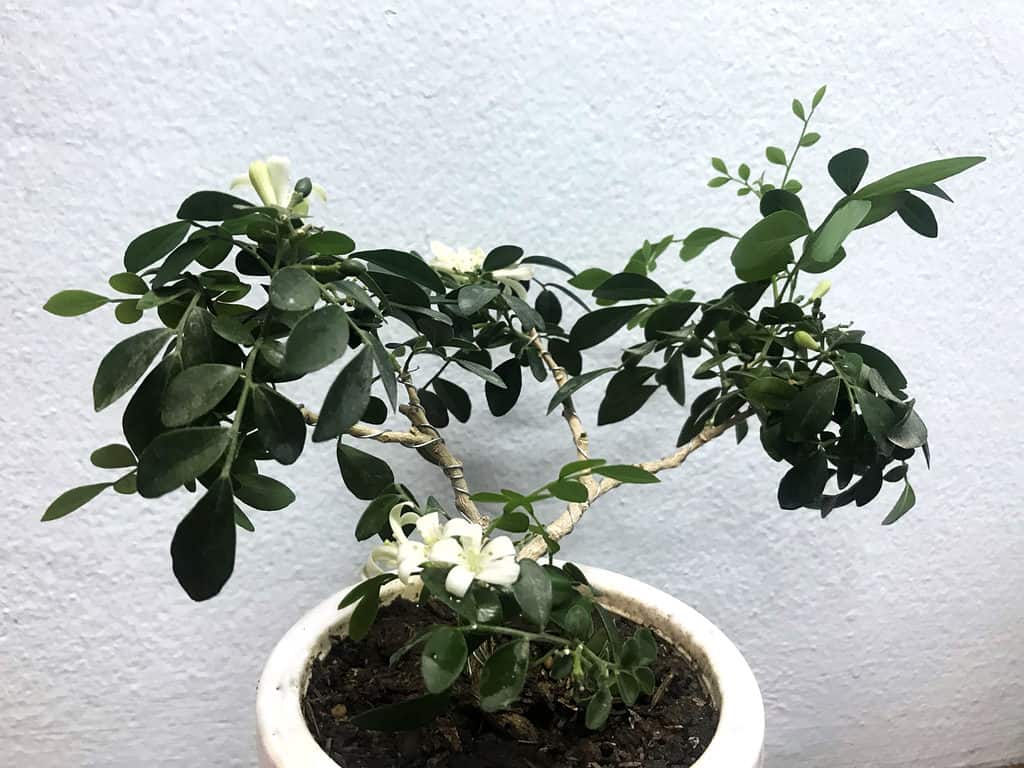
Depending on the jasmine plant species, some options are more tolerant of over or under-watering, but pay special attention to your specimen when you first start watering it.
©Visanee Mora/Shutterstock.com
Given that there are so many different types of plants known as jasmine, caring for a jasmine Bonsai tree should be done based on the specific plant species that you happen to own. However, most plants that are known as jasmine need somewhat tropical care, which means they will likely need to be grown indoors for most of the year. Let’s take a closer look at how to best care for your jasmine Bonsai tree.
Sunlight
All flowering Bonsai trees require full and bright sunlight in order to produce plenty of fragrant blooms. Jasmine Bonsai trees are no exception, requiring plenty of sunshine year-round. You may consider purchasing indoor grow lights if you are worried about your jasmine Bonsai tree getting enough sunshine, especially given the fact that your tree will need to be kept indoors during the colder months of the year.
Soil Type
All jasmine plants will suffer if kept too moist, and jasmine Bonsai trees are no exception. Choose a Bonsai tree soil mixture that promotes fast drainage so that you never have to worry about root rot for your jasmine plant. You may also choose to incorporate types of clay and rocks to further promote drainage, as your jasmine plant will appreciate it!
Water
As previously mentioned, too much water is surely the death of any Bonsai tree, including the jasmine plant species. However, jasmine plants enjoy plenty of moisture, particularly during the hotter months of the year. Keeping your jasmine Bonsai tree consistently moist but not drowning is always a good idea, but this is a hard balance to strike. Depending on the jasmine plant species, some options are more tolerant of over or under-watering, but pay special attention to your specimen when you first start watering it.
Placement
Jasmine Bonsai trees need to be placed indoors for most of the year unless you live in hardiness Zones 8 through 11. Certain jasmine plant species are more cold or heat-tolerant, depending. However, all Bonsai trees need protection from the extreme cold given that they have very little soil over their roots. This is especially true for jasmine Bonsai trees, given the fact that they are somewhat tropical and require high heat and high humidity levels.
A south-facing window in your home is always a good idea for any Bonsai tree, but jasmine Bonsai trees will particularly enjoy this spot for its ample sunshine! You may also place your jasmine Bonsai tree under grow lights, especially during the fall and winter. If your climate supports it, vacationing your jasmine Bonsai tree outdoors during the summer is the perfect option for simulating a natural climate and growth habit.
Pruning Your Jasmine Bonsai Tree

No matter the jasmine Bonsai tree species you choose, nearly all types can be cultivated from a cutting, carefully sanitized, and chosen from a healthy specimen.
©Olena Antonenko/Shutterstock.com
Knowing the type of jasmine Bonsai tree you have is key to learning how to prune it. However, most jasmine plants enjoy vigorous pruning and shaping, particularly in springtime when growth is new. Your plant should be pruned during this time of year to encourage plenty of flower production throughout the summer. Pruning a water jasmine Bonsai tree will also encourage smaller branch and leaf production, resulting in a more intricate style.
Depending on the jasmine species, the wiring should be done with care. Some fast-growing jasmine plants can only be wired during the fall or winter to prevent damage to their branches. Others may only need a guy wire to assist in their shape, given just how easily their young branches weave and warp!
Recommended Jasmine Bonsai Tree Styles
Most jasmine plants are suited to a variety of Bonsai tree styles. Choosing a multi-trunked design may help with any wayward branches, or a broom shape will promote plenty of flower growth in the spring. It is difficult to highlight or cultivate deadwood on most jasmine plant species, so keep this in mind when choosing a style and pruning toward a particular goal.
Propagating Your Jasmine Bonsai Tree
No matter the jasmine Bonsai tree species you choose, nearly all types can be cultivated from a cutting, carefully sanitized, and chosen from a healthy specimen. Taking a cutting from an older branch is recommended, as new growth doesn’t always result in a strong Bonsai tree.
You can also grow a jasmine Bonsai tree from seed, but this will take significantly longer than when grown from a cutting. However, you may also find that your local hardware store has a jasmine plant that’s the perfect size for pruning and shaping, and for a good price!
Common Problems with Jasmine Bonsai Trees
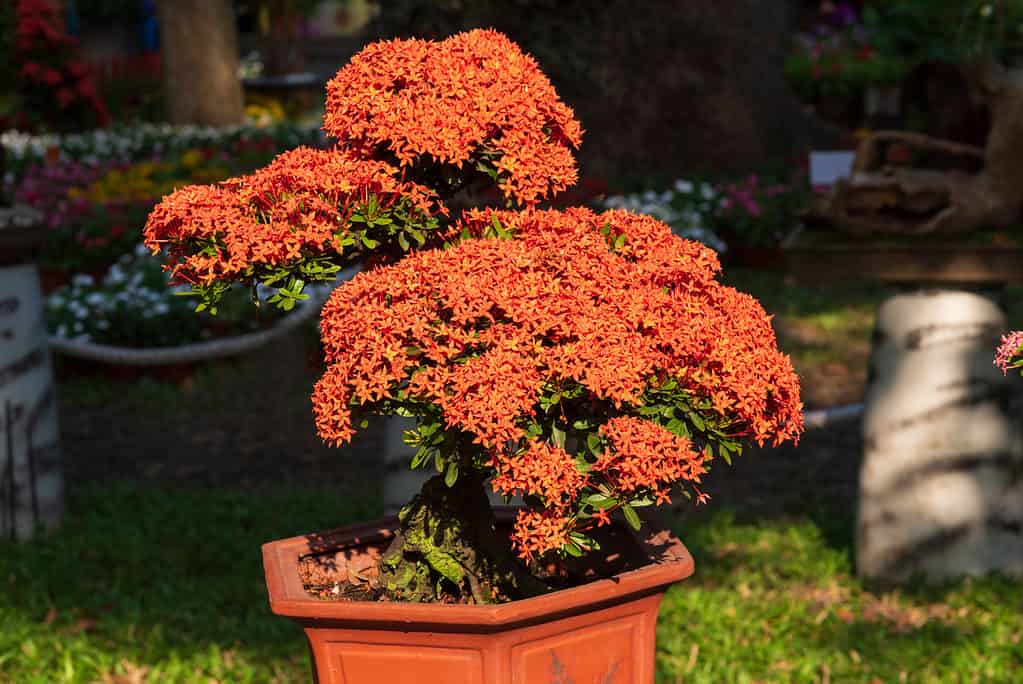
It is difficult to highlight or cultivate deadwood on most jasmine plant species, so keep this in mind when choosing a style and pruning toward a particular goal.
©KernelNguyen/Shutterstock.com
Whether you have a water jasmine Bonsai tree or a different species of jasmine plant, there are a number of problems and pests that plague them. If your jasmine Bonsai tree doesn’t produce flowers, you may need to find a different location that offers your specimen more sunshine. You may also need to adjust your fertilizing routine and ensure that your jasmine Bonsai tree is getting enough food.
The foliage of your jasmine Bonsai tree will be a good indicator as to whether or not it is receiving enough sunshine, food, and water. If you noticed that the leaves on your jasmine plant are wilting or turning yellow, adjusting its watering routine should be the first thing you do. Practice makes perfect, and your jasmine plant is likely hardy enough to handle some adjustments to its care!
Besides this, most jasmine Bonsai trees are plagued by the same issues that plague most houseplants. You may want to purchase a simple insecticide or pesticide to assist with this matter. Some common pests that may bother your jasmine Bonsai tree include spider mites, scale, mealybugs, and gnats.
Growing a jasmine Bonsai tree takes practice and may not be the best choice for the beginning Bonsai tree artist. However, with a forgiving growth habit and fragrant flowers, training a jasmine Bonsai tree may be worth it!
The photo featured at the top of this post is © NOOR RADYA BINTI MD RADZI/Shutterstock.com
Thank you for reading! Have some feedback for us? Contact the AZ Animals editorial team.






